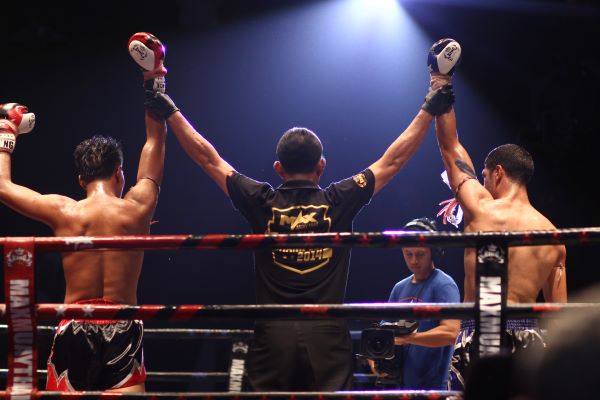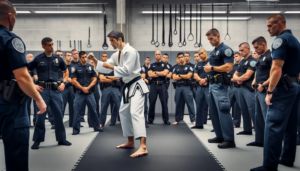
Are you wondering why Muay Thai fighters wear armbands?
In this article, we’ll explain why Muay Thai fighters wear armbands, what the armbands are, what materials Pra Jiads are made from, and whether a Muay Thai armband ranking system exists.
Contents
Why Do Muay Thai Fighters Wear Armbands?
Muay Thai fighters wear armbands known as Pra Jiad (Bpra Jiat) because they see them as talismans of good luck, protection, and support to help them during a fight and to remain healthy after it.
The armbands have been a part of Muay Thai culture since the 16th century when a piece of clothing was tied around the arm of warriors by their mothers before they left for war.
It was seen as a token of good luck and protection to ensure a safe return home, and this culture has been passed down through the generations of Muay Thai fighters who now wear armbands during an organized fight rather than on the battlefield.
Pra Jiads are also commonly blessed by a Reusi (hermit) or a monk, especially the ones worn on the battlefield or in a Muay Thai fight.
Fighters feel this makes the Pra Jiad sacred and connected to their spiritual beliefs, as well as conducive to their success in an upcoming fight.
When the Pra Jiad is being blessed, some Muay Thai fighters ask the blesser to say a prayer asking for a particular strength. This may be a prayer for knockout power, speed, or simply to remain healthy.
Before and more so after a blessing, Pra Jiads are considered sacred and shouldn’t touch the ground or be stepped on.
Traditionally, Pra Jiads were kept in high places to avoid either from happening. However, if either of these happens, the Pra Jiad is considered bad luck and the fighter gets a new one.
Is Pra Jiad Mandatory for Muay Thai Fights?
Pra Jiads aren’t mandatory for Muay Thai fights, which is why not every fighter wears one. Most often, it’s foreign Muay Thai fighters competing in Thailand who don’t wear a Pra Jiad as to them it doesn’t have the same meaning.
Most Muay Thai fighters don’t wear an armband in the gym and only wear them during the ring walk and their fight as they’re sacred and used for combat or war.
Some Muay Thai fighters wear two armbands (Pra Jiads) when fighting, but this is a personal preference and doesn’t have any significance.
Fighters wear the armbands just above the bicep below the shoulder. Pra Jiads aren’t decorative and they don’t denote ranking in a Muay Thai gym in Thailand.
What Material Are Pra Jiads Made From?
Originally, Pra Jiads were made from a sarong, which is a piece of fabric worn around the waist as a long skirt. Most often, these sarongs used to make the Pra Jiads would have been from cotton from the 16th century onward.
Now, Pra Jiads are still made from cotton or cloth, but more typically they’re made from nylon or hemp rope, or a combination of both.
The nylon or hemp rope Pra Jiads are more commonly worn by Muay Thai fighters because their gym can bulk order from a manufacturer for a cheaper price, rather than having to hand make them like they used to.
What Is the Muay Thai Armband Ranking System? (Pra Jiad Colors)
In Thailand, there isn’t a Muay Thai armband ranking system and the Muay Thai fighters only wear an armband (Pra Jiad) during their ring walk and fight.
Most Muay Thai fighters wear the same armband in the gym (if rarely worn), and even if they’re made of different materials, they don’t denote any kind of ranking.
There isn’t a Muay Thai armband ranking system in Thailand because they believe it detracts from the armband’s true meaning and culture.
To Thais, Pra Jiads are cultural and are meant to be worn when competing as talismans of protection and good luck, not as symbols of hours spent training under one specific coach.
Also, in Thailand Muay Thai is a way of life, and for most practitioners, it’s a career and a way to provide for their family, rather than merely a hobby where they can be enticed or motivated to train for an extra week by fancy colors.
However, in the West in countries like the USA and some European countries, many Muay Thai schools have introduced their own Muay Thai armband ranking system or adopted one already created by a major Muay Thai association.
For example, the United World Muay Thai Association (UWMTA) is one of the biggest in America and has identified the top 3 Muay Thai armband ranking systems in use today.
They are the (1) Khan level ranking system, (2) tassels-only ranking system, and (3) certificate-only level grading and rank system.
Khan level ranking system
- 1st Khan – White
- 2nd Khan – Yellow
- 3rd Khan – Yellow and White
- 4th Khan – Green
- 5th Khan – Green and White
- 6th Khan – Blue
- 7th Khan – Blue and White
- 8th Khan – Brown
- 9th Khan – Brown and White
- 10th Khan – Red
- 11th Khan – Red and White (Instructor trainee)
- 12th Khan – Red and Yellow
- 13th Khan – Red and White (Instructor)
- 14th Khan – Silver
- 15th Khan – Gold
Tassels only ranking system
- White – Beginner Student
- Yellow – Basic Knowledge
- Green – Intermediate
- Blue – Advanced Knowledge of Muay Thai Techniques
- Black – Advanced knowledge of Muay Thai Techniques and Theory
- Red – Junior Instructor
- Red and Black – Instructor / Kru
Certificate only level grading and rank
- Level 0 – 6 Months (White belt equivalent)
- Level 1 – 6 Months (Yellow belt equivalent)
- Level 2 – 6 Months (Orange belt equivalent)
- Level 3 – 6 Months (Purple belt equivalent)
- Level 4 – 6 Months (Blue belt equivalent)
- Level 5 – 6 Months (Green belt equivalent)
- Level 6 – 6 Months (Brown belt equivalent)
- Level 7 – 6 Months – 4 years of training in total (Black belt equivalent)
- Level 8 – 5 to 6 years of training in total (2nd Dan Black belt equivalent)
- Level 9 – 8 years of training in total (3rd Dan Black belt equivalent)
- Level 10 – 5 years of teaching (5th Dan Black belt equivalent)
- Level 11 – 10 years of teaching (8th Dan Black belt equivalent)
- Level 12 – 20 years of teaching (10th Dan Black belt equivalent)
These schools believe the system is great for helping students keep track of their progress and motivated to keep training – especially for practitioners who don’t compete and have no intention to.
Here’s a short two-minute video showing the BETA Academy’s Muay Thai armband ranking system.
As can be seen, this school has 13 Muay Thai armband ranks which look like this:
- White Band
- Yellow Band
- Orange Band
- Green Band
- Blue Band
- Blue II Band
- Purple Band
- Purple II Band
- Red Band
- Red II Band
- Brown Band
- Brown II Band
- Black Band
Overall, it should be considered that there isn’t a Muay Thai armband ranking system, as the home of Muay Thai (Thailand) doesn’t use one.
Even in the West, there isn’t a widely accepted Muay Thai armband ranking system.
The ranking system used by each school varies depending on the association they’ve joined, and there are also just as many Muay Thai gyms/schools that don’t use a Muay Thai armband system as they prefer to reserve the cultural traditions of Muay Thai.
The Bottom Line
So, ‘why do Muay Thai fighters wear armbands?’
Muay Thai fighters wear armbands known as Pra Jiad because they see them as talismans of good luck, protection, and support to help them during a fight and to remain healthy after it.




